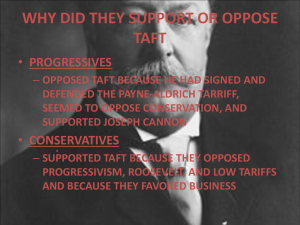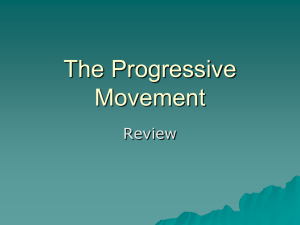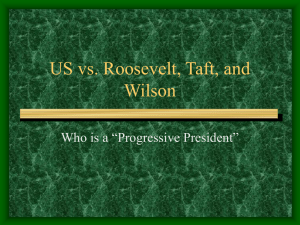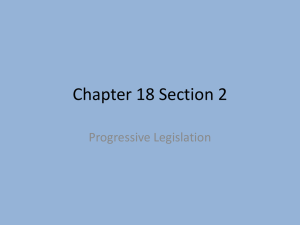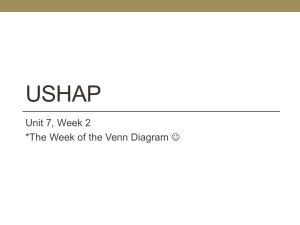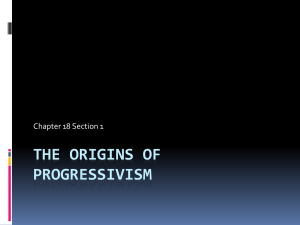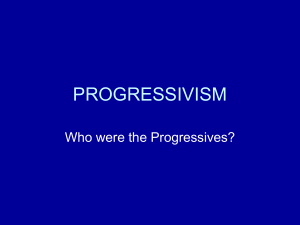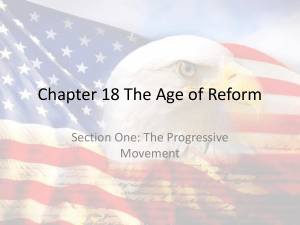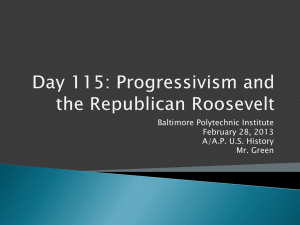Progressive Era
advertisement
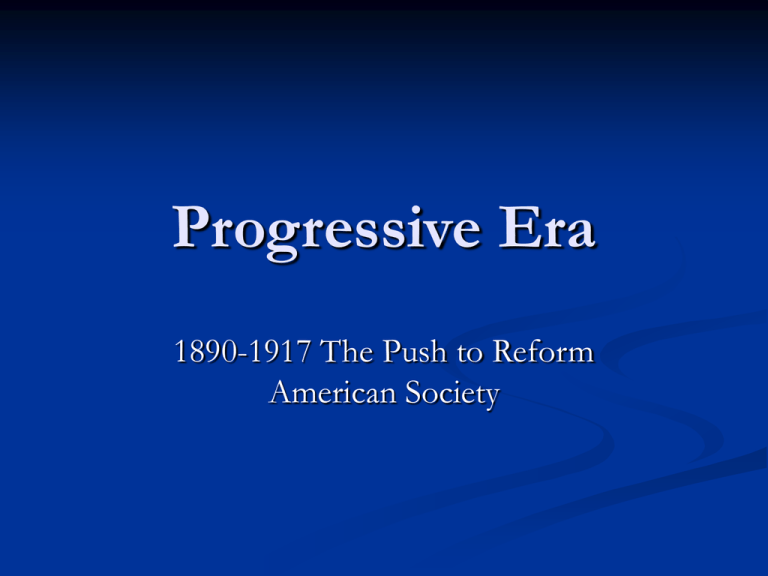
Progressive Era 1890-1917 The Push to Reform American Society Causes Gilded Age political corruption Negative views of laissez faire approach Monopolies Working conditions Child Labor Abuses Urban living conditions Discrimination towards Women, African Americans, and immigrants Populist Movement Goals of the Progressives Government Accountability Regulation over monopolies and companies Expansion of government power to help citizens End government inefficiency, corruption, and patronage Progressives were White Protestants Middle class and native born. College Educated Professionals Social workers Scholars Politicians Preachers Teachers Writers Populists vs Progressives Populists---rural Progressives---cities Populists were poor and uneducated Progressives were middle-class and educated. Populists were too radical Progressives stayed political mainstream. Populists failed Progressives succeeded Social Reformers Muckrakers exposed the problems Low living standards in cities Immigrants squalid living Health / Food Standards Child Labor / Working Conditions Key People: Upton Sinclair, Ida Tarbell, Jacob Riis, and Thomas Nast Social Reformers Prison Reform Shelters for homeless and mentally ill Public Education system Women’s entrance into public forum led to emphasis on morality Social and Political Crossover Women’s Rights Groups Crusade for Change Suffragists / Suffragettes, NAWSA, Congressional Union Temperance Movement Key people: Reformers- Jane Addams and “Mother” Jones Key People: Suffragists- Susan B. Anthony, Elizabeth Cady Stanton, Lucretia Mott, and Alice Paul Political Reforms Progressive Changes to Government Basis for social welfare programs -Welfare, unemployment, and Social Security Direct Primaries 17th Amendment- Direct Senate Election Initiatives / Referendums Recalls Secret Ballots Economic Reformers Muckrakers exposed corruption of some monopolies Rise of Labor Unions Knights of Labor American Federation of Labor Better working conditions, shorter hours, more pay Progressive Presidents •Theodore Roosevelt 1901 to 1909 •William Howard Taft 1909 to 1913 •Woodrow Wilson 1913 to 1921 Progressive Presidents Teddy Roosevelt 1901-1909 Republican Active approach to executive branch “Square Deal” First to recognize unions Trustbuster Railroad Regulation Public Health Conservationist / National Parks Progressive Presidents William H. Taft 1909-1913 Republican Progressivism election strategy Failed on lower tariff promise Anti Trust Cases Reserved Public Lands Corruption and Scandals Received criticism from all parties and factions Election of 1912 Republicans- Taft Progressive / Bull Moose Party- Roosevelt Democrats- Wilson Socialist- Debs Republican Party Platform Taft High import tariffs. Put limitations on female and child labor. Workman’s Compensation Laws. Against initiative, referendum, and recall. Against “bad” trusts. Creation of a Federal Trade Commission. Stay on the gold standard. Conservation of natural resources because they are finite. Progressive Party (Bull Moose Party) Platform Roosevelt Women’s suffrage. Graduated income tax. 8 hour work day More regulation of big business Lower tariffs. Limits on campaign spending. Minimum wage laws. Abolition of child labor. Workmen’s compensation. N e w N a t i o n a l i s m Socialist Party Platform Debs Government ownership of railroads and utilities. Guaranteed income tax. No tariffs. 8-hour work day. Better housing. Government inspection of factories. Women’s suffrage. Democratic Party Platform Wilson N e w F r e e d o m Critical of big business and big government Tariff reduction. Direct election of Senators. Create a Department of Labor. Strengthen the Sherman Anti-Trust Act. Did NOT support women’s suffrage. Opposed to a central bank. Election of 1912 Progressive Presidents Woodrow Wilson 1913-1921 Lowered Tariffs Graduated Income Tax Avoided WWI for first term Entered into WWI for second term (some say it was calculated move)
